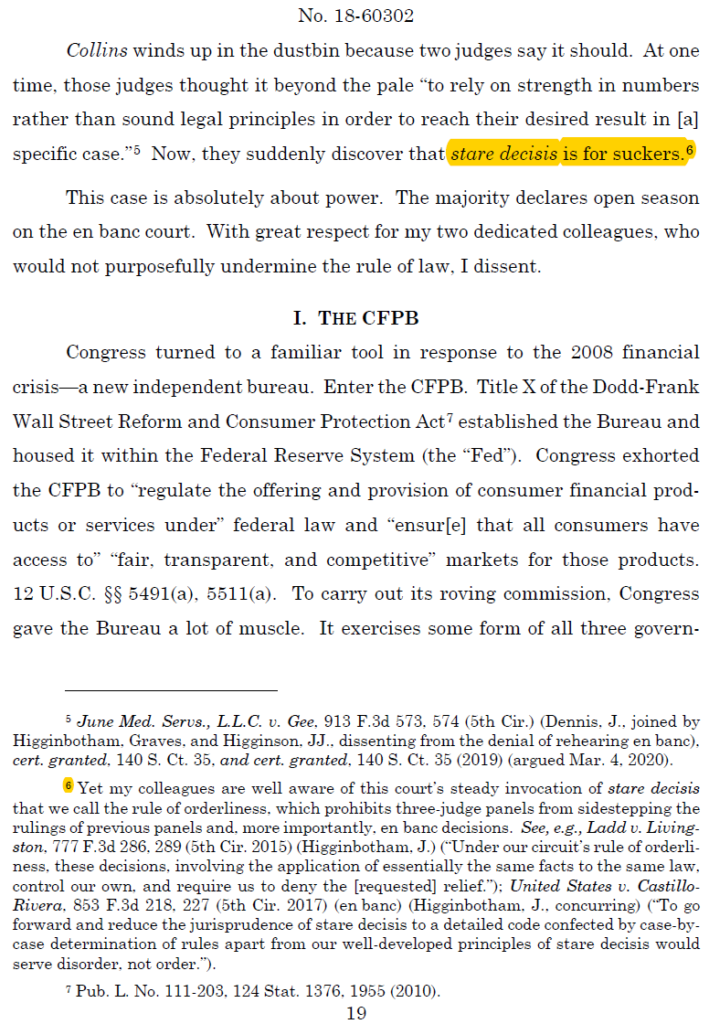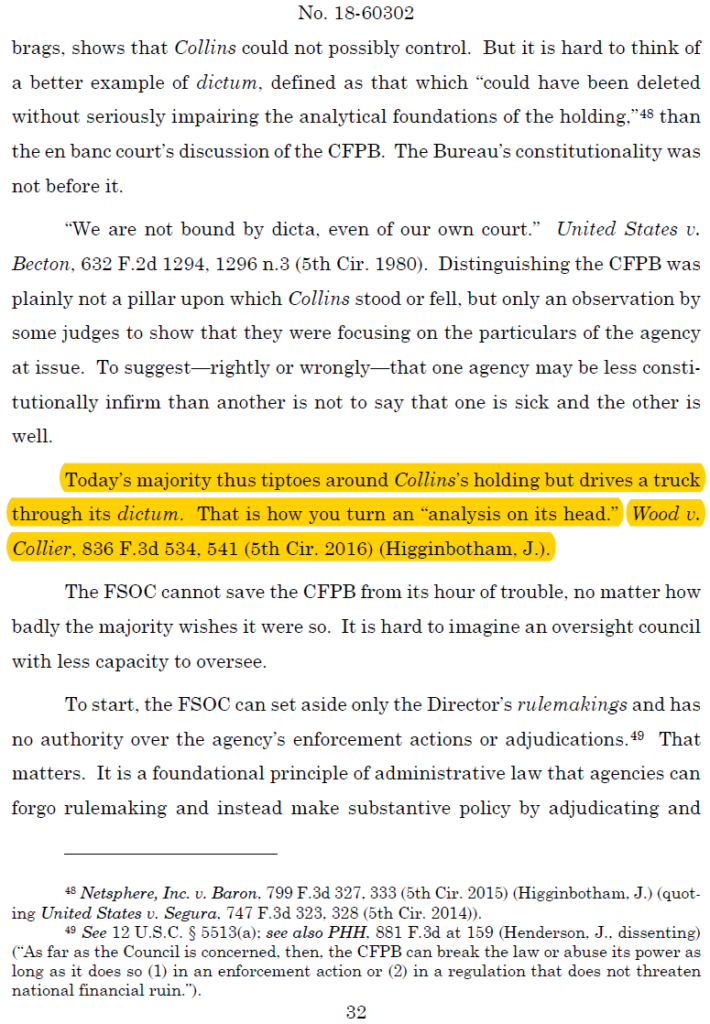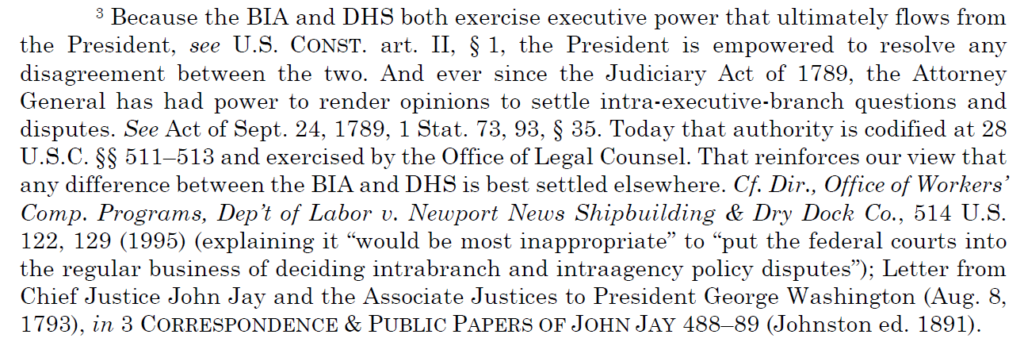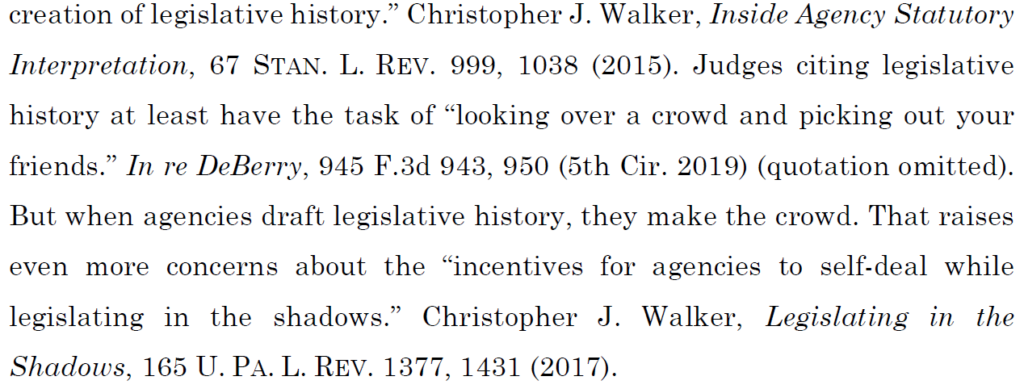Fifth Circuit Review – Reviewed: Judge Smith Listens To Strict Scrutiny (UPDATED March 17, 2020)
UPDATE: My original post, which appears unchanged below, confidently declares that Judge Smith’s invocation of the slogan “stare decisis is for suckers” in his CFPB v. All Am. Check Cashing dissent shows that Judge Smith listens to Strict Scrutiny. Since then, I received this helpful note from Professor Jonathan H. Adler, explaining why he doubts that is so:
I doubt Judge Smith got “Stare decisis is for suckers” from Strict Scrutiny. This phrase — often styled as “stare decisis is fo’ suckas” — had some currency 10-15 years ago in the conservative legal blogosphere. There were even t-shirts. Google will pull up lots of references to both formulations that predate Strict Scrutiny’s launch, including quite a few that reference the now-defunct Southern Appeal blog.
Thanks to Professor Adler for the correction, and mea culpa!
* * *
Welcome to another installment of Fifth Circuit Review – Reviewed! We’ve learned a lot over the last thirty days or so, including that:
- Judge Smith listens to Strict Scrutiny;
- While the Fifth Circuit agrees 12-4 that the Federal Housing Finance Agency is unconstitutional, it also agrees 2-1 that the similarly structured Consumer Financial Protection Board is just fine;
- Judge Oldham is a big Chris Walker fan; and
- ALJs applying the Social Security Administration’s “borderline situations” rule must show more work to pass survive substantial evidence review in the Fifth Circuit than the Ninth.
Before we get to all that, though, I have an update to share.
Confirmed: Everything’s Bigger In Texas
My last Fifth Circuit Review – Reviewed reported that Texas is a country. See General Land Office v. Department of the Interior, 947 F.3d 309, 315 (5th Cir. 2020). In response, I received several fun Texas stories. Here, for example, is one from Professor Peter L. Strauss:
One of the funniest episodes I witnessed, that corresponds with your observation, occurred at the 1976 convention of the National Association of State Attorneys General, held that year in San Antonio. At the ceremonial banquet, the AG of Texas got up to introduce an honored guest, the member of the U.S. House of Representatives from the single largest geographic district in the country. You will not be surprised to learn, but I was (as, I suspect were the AGs of Alaska, Montana, Nevada …), that this was the representative sent to Washington from El Paso.
I love these stories, so please keep them coming!
General Land Office already has detractors, too, though. In a case Aaron Nielson covered in a recent edition of D.C. Circuit Review-Reviewed (Jackson v. Modly, 949 F.3d 763 (D.C. Cir. 2020)), for example, the D.C. Circuit criticized General Land Office for treating 28 U.S.C. § 2401(a)‘s timing requirement as jurisdictional. According to Jackson, the Supreme Court rejected that view in United States v. Kwai Fun Wong, 575 U.S. 402 (2015). See Jackson, 949 F.3d at 776-77 & n.13. Oh well, you can’t please everybody.
That’s it for updates. On to the new cases!
Stare Decisis Is For Suckers
Last Tuesday, the Supreme Court heard argument in Seila Law v. CFPB, a case in which the Court will decide whether the CFPB’s structure violates separation-of-powers principles. That same day, a divided panel of the Fifth Circuit addressed the same question, siding with the Ninth and D.C. Circuits in concluding it does not. See CFPB v. All Am. Check Cashing, No. 18-60302 (5th Cir. Mar. 3, 2020) (Higginbotham, Smith, Higginson).
The Supreme Court will decide Seila Law soon enough, so I won’t discuss the merits here. Instead, I’ll focus on Judge Smith’s dissent, which is epic. First, though, a little context.
The en banc Fifth Circuit recently declared the similarly structured FHFA unconstitutional by a 12-4 margin in Collins v. Mnuchin. Judge Smith, who was part of the Collins majority, apparently believed that case made the unconstitutionality of the CFPB a foregone conclusion in the Fifth Circuit. So when two of his colleagues held otherwise before the 123-pages of en-banc ink spilled on Collins could dry, he didn’t just think their opinion was wrong. He viewed it as “the asserted prerogative of two judges to abandon en banc precedent they dislike.” In response, he channeled his inner Jules Winnfield to pen a real “Guns of the Navarone” dissent.
In this first passage, Judge Smith uncorks a Strict-Scrutiny-themed zing (don’t miss the follow-through in the footnotes):

Next, he uses a helpful metaphor to”drive” his point home:

And finally, a strong finish:


I cover this case in greater depth here.
Ali v. Barr: Ambiguity Is In The Eye Of The Beholder
In Ali v. Barr, No. 17-60604 (5th Cir. Feb. 24, 2020) (Ali II) (Jones, Ho, Oldham), the Fifth Circuit held that an immigrant’s asylee status ends when he voluntarily adjusts to lawful permanent resident (LPR) status under 8 U.S.C. § 1159(b). From a statutory-interpretation perspective, Judge Oldham’s opinion for the Court is fascinating. Indeed, I’ve spent far too much time attempting to figure out what I think about it, and I’m still not entirely sure.
For what it’s worth, my current view is that the Court’s reasoning regarding Chevron Step Zero is problematic and reveals an apparent hostility to the Chevron Step-One-And-A-Half doctrine that I love so dearly. If you’re interested in my analysis supporting those positions, it’s available here. But because it’s too long (and unsettled) to be included in a Fifth Circuit Review – Reviewed, however, I’ll limit this discussion to other important (but more straightforward) takeaways from the Court’s opinion.
First, noting that the BIA’s statutory interpretation conflicted with Department of Homeland Security regulations, Ali had argued that Encino Motorcars required that the Board acknowledge and explain the shift in policy. The Court rejected that argument, holding that Encino Motorcars only applies when an agency changes its own previously expressed view of the law. In a footnote, the Court added this interesting coda to its discussion of the BIA-DHS relationship:

Second, the Court rejected Ali’s argument that the BIA’s interpretation misunderstood the INA’s legislative history. Along the way, it references not one but two articles by some guy named “Christopher J. Walker”:

I’ll leave it there for now. If I’m ever happy with my analysis of the deeper statutory-interpretation issues, I’ll post it here separately.
Schofield v. Saul And The Borderline-Situation … Situtation
In Schofield v. Saul, No. 18-11390 (5th Cir. Feb. 22, 2020) (Elrod, Oldham, Graves), the Court announced an important rule for substantial evidence review and deepened a circuit split in the process. At issue was the Social Security Administration’s denial of Schofield’s application for disability benefits.
Social security regulations divide disability claimants into three age categories. 20 C.F.R. § 404.1563(c)-(e). Where a claimant is within a few days or a few months of reaching an older age category–a “borderline situation”–ALJs have discretion to use the older age category when determining whether a disability benefits claimant could do other work. Id. § 404.1563(b).
At the time relevant under the governing regulations, Schofield was about four months shy of qualifying as “a person of advanced age.” The ALJ treated Schofield as “a person closely approaching advanced age”–instead of using the older age category–and concluded Schofield wasn’t disabled. The ALJ didn’t explain why she didn’t treat Schofield as a person of advanced age, but she did cite some of the relevant regulations.
Although ALJs must consider whether to use an older age category in a borderline situation, the regulations don’t expressly require them to explain in their written decisions why they didn’t use an older age category. Id. § 404.1563(b). Some courts have held an ALJ therefore need only cite the relevant regulation to show she considered whether to use an older age category in a borderline situation. E.g., Lockwood v. Comm’r of Social Security, 616 F.3d 1068, 1071 (9th Cir. 2010). Others require more. E.g., Daniels v. Apfel, 154 F.3d 1129 (10th Cir. 1998).
Joining those circuits that require more, the Court held that “the mere citation to Schofield’s age and an SSA regulation did not provide substantial evidence to support the ALJ’s decision.”
More extensive analysis available here.
Immigration Update
Two recent published opinions extended Pierre-Paul v. Barr, 930 F.3d 684 (5th Cir. 2019), pet. for cert. filed (U.S. Dec. 16, 2019) (No. 19-779). See Yanez-Pena v. Barr, No. 19-60464 (5th Cir. Feb. 28, 2020) (Wiener, Graves, Willett); Mejia v. Barr, No. 17-60580 (5th Cir. Feb. 28, 2020) (Haynes, Oldham, Hanen). For those interested, I covered Pierre-Paul here.
Full disclosure, I filed an amicus curiae brief in support of the petition for certiorari in Pierre-Paul.



